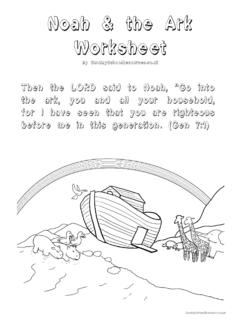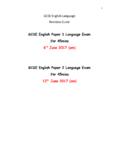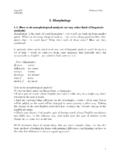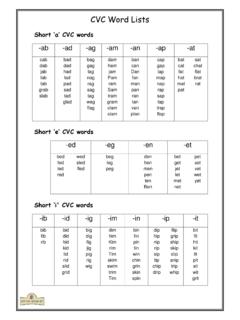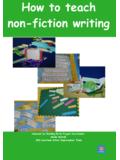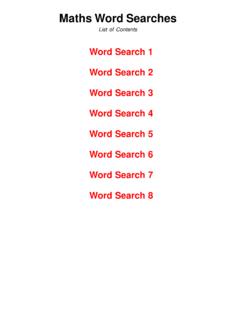Transcription of Blooms Taxonomy questions
1 Bloom s Taxonomy Bloom s Taxonomy provides an important framework for teachers to use to focus on higher order thinking. By providing a hierarchy of levels, this Taxonomy can assist teachers in designing performance tasks, crafting questions for conferring with students, and providing feedback on student work This resource is divided into different levels each with Keywords that exemplify the level and questions that focus on that same critical thinking level. questions for Critical Thinking can be used in the classroom to develop all levels of thinking within the cognitive domain. The results will be improved attention to detail, increased comprehension and expanded problem solving skills. Use the keywords as guides to structuring questions and tasks. Finish the questions with content appropriate to the learner.
2 Assessment can be used to help guide culminating projects. The six levels are: Level I Knowledge Level II Comprehension Level III Application Level IV Analysis Level V Synthesis Level VI Evaluation Blooms Level I: Knowledge Exhibits memory of previously learned material by recalling fundamental facts, terms, basic concepts and answers about the selection. Keywords: who, what, why, when, omit, where, which, choose, find , how, define, label, show, spell, list, match, name, relate, tell, recall, select questions : What Can you select? Where When did ____ happen? Who were the Which Why How would you When Can you Who How would you How did Can you list the How How would you Assessment: Match character names with pictures of the characters.
3 Match statements with the character who said them. List the main characteristics of one of the main characters in a WANTED poster. Arrange scrambled story pictures and/or scrambled story sentences in sequential order. Recall details about the setting by creating a picture of where a part of the story took place. Blooms Level II: Comprehension Demonstrate understanding of facts and ideas by organizing, comparing, translating, interpreting, giving descriptors and stating main ideas. Keywords: compare, contrast, demonstrate, interpret, explain, extend, illustrate, infer, outline, relate, rephrase, translate, summarize, show, classify questions : How would you classify the type How would you Will you state or interpret in your own How would you rephrase the meaning?
4 What facts or ideas What is the main idea of ..? Which statements Which is the best What can you say about ..? How would you ? Can you explain what is What is meant Assessment: Interpret pictures of scenes from the story or art print. Explain selected ideas or parts from the story in his or her own words. Draw a picture and/or write a sentence showing what happened before and after a passage or illustration found in the book. (visualizing) Predict what could happen next in the story before the reading of the entire book is completed. Construct a pictorial time-line that summarizes what happens in the story. Explain how the main character felt at the beginning, middle, and /or end of the story. Blooms Level III: Application Solve problems in new situations by applying acquired knowledge, facts, techniques and rules in a different, or new way.
5 Keywords: apply. build, choose, construct, develop, interview, make use of, organize, experiment with, plan, select, solve, utilize, model, identify questions : How would you How would you solve ___ using what you ve What examples can you find How would you show your understanding How would you organize _____ to How would you apply what you learned to What approach would you use What other way would you plan What would result Can you make use of the facts What elements would you use to What facts would you select to What questions would you ask during an interview? Assessment: Classify the characters as human, animal, or thing. Transfer a main character to a new setting. Make finger puppets and act out a part of the story. Select a meal that one of the main characters would enjoy eating: plan a menu, and a method of serving it.
6 Think of a situation that occurred to a character in the story and write about how he or she would have handled the situation differently. Give examples of people the student knows who have the same problems as the characters in the story. Blooms Level IV: Analysis Examine and break information into parts by identifying motives or causes. Make inferences and find evidence to support generalizations. Keywords: analyze, categorize, classify, compare, contrast, discover, dissect, divide, examine, inspect, simplify, survey, test for, distinguish, list, distinction, theme, relationships, function, motive, inference, assumption, conclusion, take part in questions : What are the parts or features of .. ? How is _____ related to .. ? Why do you think .. ? What is the theme.
7 ? What motive is there .. ? Can you list the parts .. ? What inference can you make .. ? What conclusions can you draw .. ? How would you classify .. ? How would you categorize .. ? Can you identify the different parts .. ? What evidence can you find .. ? What is the relationship between .. ? Can you make a distinction between .. ? What is the function of .. ? What ideas justify .. ? Assessment: Identify general characteristics (stated and/or implied) of the main characters. Distinguish what could happen from what couldn't happen in the story in real life. Select parts of the story that were the funniest, saddest, happiest, and most unbelievable. Differentiate fact from opinion. Compare and/or contrast two of the main characters. Select an action of a main character that was exactly the same as something the student would have done.
8 Blooms Level V: Synthesis Compile information together in a different way by combining elements in a new pattern or proposing alternative solutions. Keywords: build, choose, combine, compile, compose, construct, create, design, develop, estimate, formulate, imagine, invent, make up, originate, plan, predict, propose, solve, solution, suppose, discuss, modify, change, original, improve, adapt, minimize, maximize, theorize, elaborate, test, happen, delete questions : What changes would you make to How would you What would happen Can you elaborate on the Can you propose an Can you How would you adapt _____ to create a How could you change (modify) the plot (plan)..? What facts can you What way would you What could be combined to improve (change).
9 ? Suppose you could _____what would you How would you Can you formulate a theory Can you predict the outcome How would you estimate the results What could be done to minimize (maximize)..? Can you construct a model that would How is _____ related Can you think for an original way for What are the parts or features Why do you What is the What motive is Can you list the What inference can you ..? What ideas What conclusions can you How would you How would you Can you identify the different What evidence can you What is the relationship Can you make the distinction What is the function of Assessment: Create a story from just the title before the story is read (pre-story exercise). Write three new titles for the story that would give a good idea what it was about.
10 Create a poster to advertise the story so people will want to read it. Use your imagination to draw a picture about the story. Create a new product related to the story. Restructure the roles of the main characters to create new outcomes in the story. Compose and perform a dialogue or monologue that will communicate the thoughts of the main character(s) at a given point in the story. Imagine that you are the main character. Write a diary account of daily thoughts and activities. Create an original character and tell how the character would fit into the story. Write the lyrics and music to a song that one of the main characters would sing if he/she/it became a rock star and perform it. Blooms Level VI: Evaluation Present and defend opinions by making judgments about information, validity of ideas or quality of work based on a set of criteria.

